Feature
Science to Story, Story to Social
Connected Science Learning April–June 2020 (Volume 2, Issue 2)
By R. Justin Hougham, Isabelle Herde, Jennifer Loveland, Sarah Olsen, Tempestt Morgan, Maggie Steinhauer, Zoë Goodrow, Max Myers, and Sarah Oszuscik
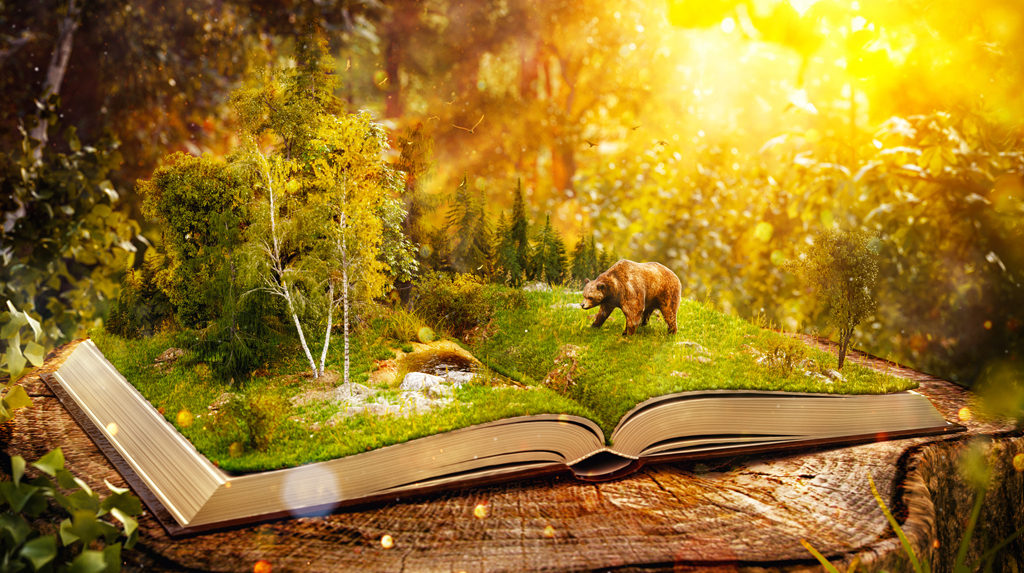
Social media presents both a threat and an opportunity for science communication and data literacy. When uncritically consumed or when students are not encouraged to create learning artifacts for distribution, social media can certainly act as a distraction from learning and the classroom. However, we advocate that the tension around social media in learning environments can be reframed through an intentional process of bridging science communication and social media, which has the potential to enrich the dialogue between classroom and out-of-school learning environments. Because many students are learning outside of the traditional classroom and relying more on digital and online platforms during the COVID-19 pandemic, bridging classroom experiences and home life is essential. We propose a Scientific Storytelling approach to inquiry-based instruction, designed to engage learners in science practices and creativity, and encourage them to share their learning with community members. This approach provides an opportunity for schools and informal science education organizations to re-examine the intentional curation of digital footprints online to more adequately reflect 21st-century STEM (science, technology, engineering, and math) education. In addition to needing ways to engage their students, teachers also need methods for tracking student engagement. Scientific Storytelling also provides a pathway for students to produce for teachers trackable digital artifacts, which are the products of engaging with educational material.
During the COVID-19 pandemic, people have been spending more time online and on social media and rely on these platforms to continue their lives with as few hindrances as possible. The pandemic will likely have long-lasting effects on the way people, including students and teachers, use social media platforms and other forms of online engagement. This demonstrates an increased need for educational online engagement and connections. The shareable format of Scientific Stories can be used to revisit content, share ideas, connect with others, and demonstrate student engagement with educational material.
Preparing students for the 21st-century workforce requires an emphasis on creativity, innovation, and communication/literacy skills. Although this is in alignment with current goals of science education, teachers and students require scaffolding to integrate these skills this content area (Ostler 2012). At Upham Woods Outdoor Learning Center, we develop and facilitate youth programming and teacher trainings to support these goals in both formal and informal learning environments. Here, we highlight our work in developing the Scientific Storytelling approach, focusing on specific needs in science education to support 21st-century skills in science communication, scaffolded language acquisition, creativity, and data literacy.
Current needs for preparing the 21st-century STEM workforce
Science communication
Although communicating science to the general public is increasingly recognized as a responsibility of scientists (Dahlstrom 2014), K–12 science education does not currently prepare students to be effective science communicators. Communication training for scientists is often focused around storytelling and translating science into narrative forms that are more easily understood by nonscience audiences. However, this type of science communication represents a challenge in science teaching, where students struggle to bridge everyday language with disciplinary discourse (Lemke 1990). Students need opportunities to share knowledge in a nontechnical, yet still scientific, manner and to develop science communication skills in alignment with current demands in STEM fields.
Scaffolded language acquisition
For many students, language is a barrier to learning science. In a meta-analysis of skills and knowledge needed for the 21st-century STEM workplace, Jang (2016) identified the most important ones required for working in STEM disciplines. In addition to critical thinking, the most important skills were reading comprehension, active listening, and speaking. The most important knowledge domain was English language. These language and literacy skills, however, receive less focus as a goal of science education. Recently, researchers have called for a shift away from “teaching” discrete language skills to a focus on supporting language development within appropriate contexts and experiences, so-called “language-in-use environments” aligned with experiential learning approaches (Lee , Quinn, and Valdés 2013). Storytelling can work as a bridge between everyday language and scientific language and concepts. Bridging common and scientific language is needed to facilitate students’ knowledge integration of scientific language and concepts with more familiar types of communication, and is especially important for English language learners (ELLs) and students from nondominant cultures (Lee, Quinn, and Valdés 2013).
Creativity in science
Scientific knowledge generation necessarily involves human imagination and creativity. Although creativity plays an essential role in developing explanations and generating novel ideas, it receives little explicit development in science standards. Preparing learners for the 21st century, a time in which artificial intelligence will replace much of the work we are currently preparing students to do, necessitates a focus on creativity and imagination, which are perhaps the most important skills for the future workforce.
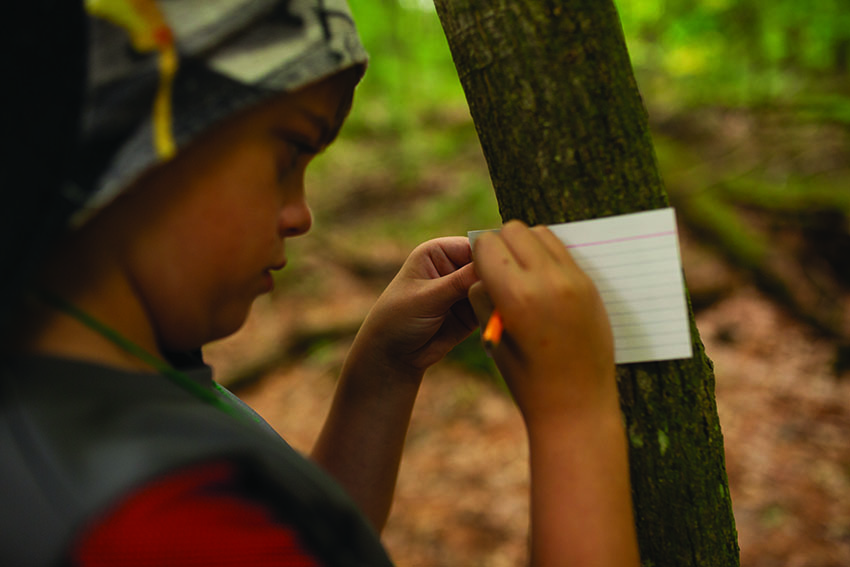
Data literacy
Students need more experiences that develop their capabilities to engage with science in ways relevant to the problems and practicalities of their lives, which is the way most adults interact with science. Data literacy is a 21st-century skill defined as the “the knowledge and skills in collecting, processing, managing, evaluating and using data” (Qin and D’Ignazio 2010, p. 3). Data literacy is therefore inextricably connected to evidence-based thinking, interpretation of information from data, developing inferences and explanations, and using data to solve real problems and communicate their solutions (Vahey et al. 2006). Despite the importance of data literacy for today’s society and science inquiry itself, it is not always realized in classroom practice (Vahey et al. 2006).
The Scientific Storytelling approach
The Scientific Storytelling approach guides students from real, concrete science experiences to communication of those experiences using imagination and creativity. Students begin by engaging in science practices including observation, data collection, and analysis. Students capture data, which may include photos or video, to document their science experience. The science experience and the data gathered are what ground the scientific story in reality. From here, students (individually or in groups) transform that reality (data and observations) into a Scientific Story of their own invention. This process is outlined in Table 1. Although the reality of the scientific data remains unchanged, the story developed by the student provides context, narrative, and meaning. Scientific Stories can take many forms, including written, oral, kinesthetic, theatrical, or graphic; an example of a story can be found in Figure 1. These stories can be shared with different audiences including classrooms, schools, and communities. They can be performed live or captured digitally.
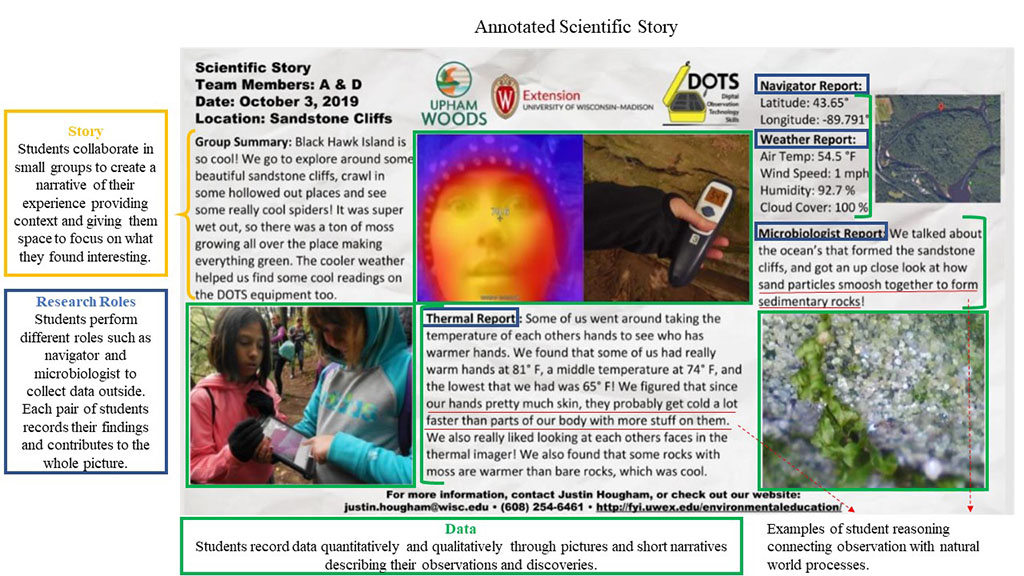
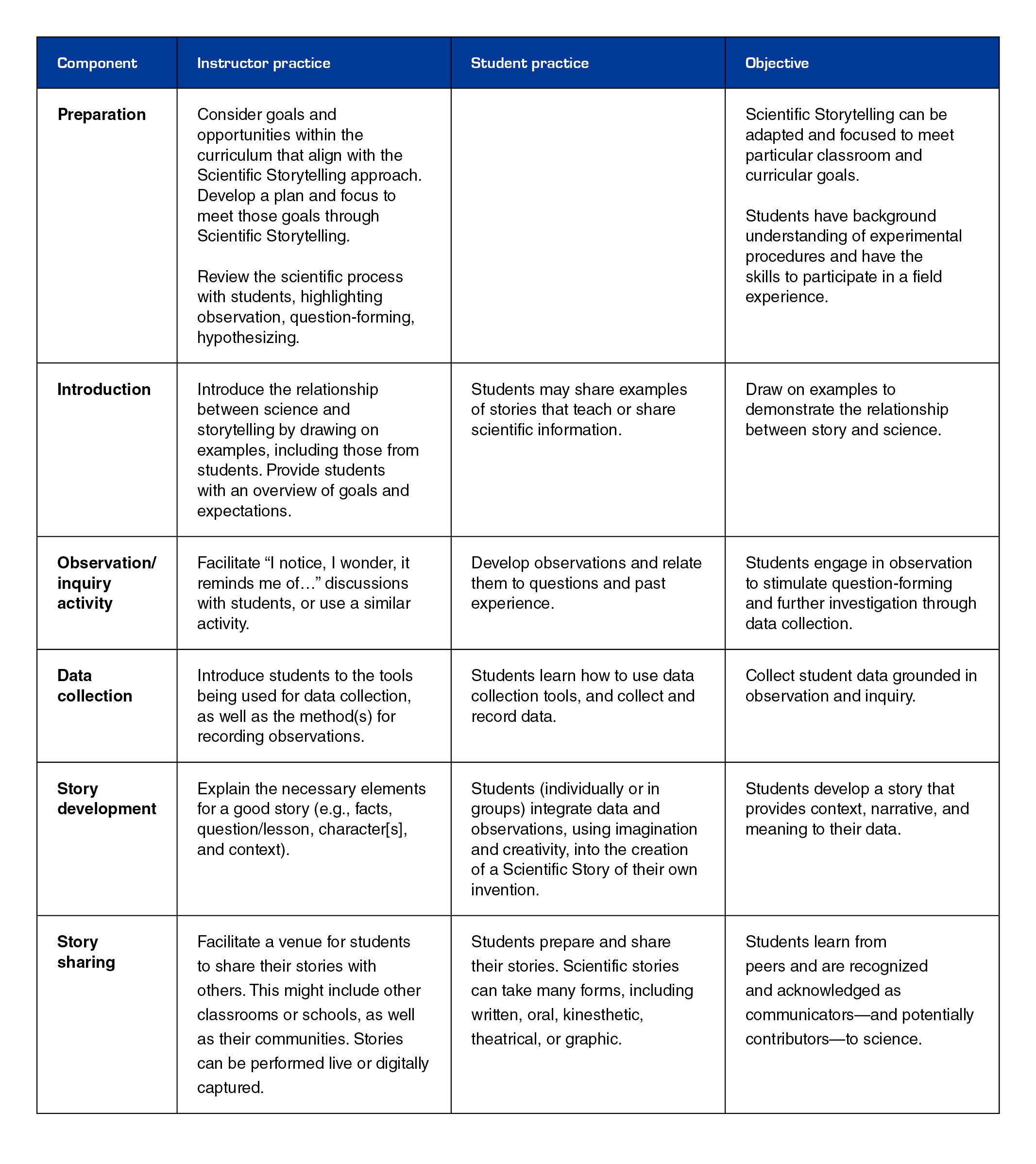
The Scientific Storytelling approach can be aligned with the Next Generation Science Standards (NGSS). The approach requires students to practice obtaining, evaluating, and communicating scientific information in an engaging way. With this approach, students also plan and carry out investigations, interpret data, and engage in arguments from evidence. These are all practices addressed in the NGSS. Teachers can tailor the Scientific Storytelling prompts to identify the NGSS disciplinary core ideas that they are already addressing in their lesson plans.
Social media as a storytelling venue
Scientific Stories exemplify what students are learning and make visible the diversity of voices, imagery, and novel content that students are producing. The stories are snapshots of student learning, excitement, and skill development that can capture an hour, a day, or a week of learning experiences through narrated information. For this reason, these stories are invaluable artifacts for students to share with families and communities. To protect student privacy, it is essential to acquire photo release permissions and be judicious in sharing student information such as school, grade, or name. Once posted on social media, the stories can be viewed and shared by family, friends, and community, expanding the reach of classroom lessons or out-of-school programming. At Upham Woods Outdoor Learning Center, we leverage the shareable format of Scientific Stories to capitalize on the social media movement and expand access of student-collected data and scientific findings to community members. In addition to family and friends, these could include businesses in the community, local government policymakers, other students, and natural resource professionals. Stories provide room for interpretation and make it possible for these stakeholders to draw their own connections in a way that lab reports cannot.
Scientific stories shared over Facebook and other platforms at the end of each educational program represent 11.5% of Upham Woods Outdoor Learning Center’s total social media reach. Reach is the number of people who see the post on their social media feeds. Figure 2 shows our social media reach by platform and the overall reach of the Scientific Stories in a typical month of programming.
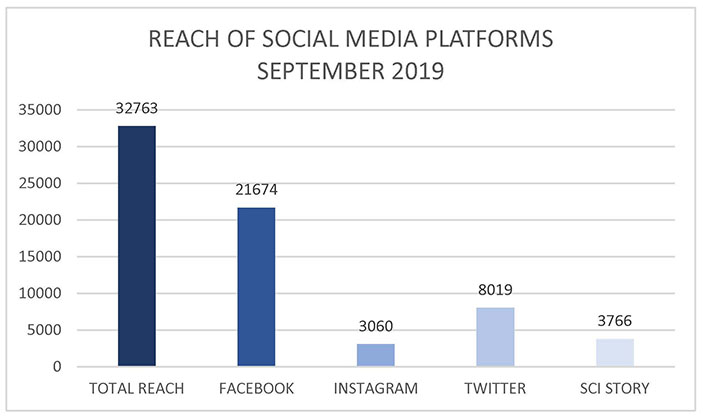
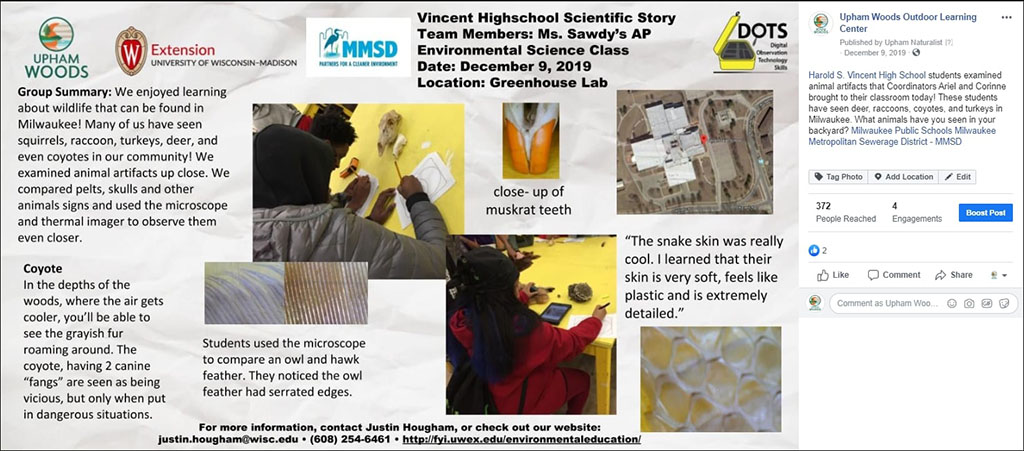
Case example
Informal and formal science educators alike can find it difficult to bridge students’ science learning across space and time. Here, we provide an example of how Scientific Storytelling was used with a fifth-grade class from La Escuela Fratney in Milwaukee, Wisconsin, to connect science experiences throughout the school year. Programming was developed collaboratively with the classroom teacher to best align with learning objectives and curriculum. Her perspective is provided at the end of this case example. This case example focuses on the progression of one student group over a four-month period, demonstrating how students use Scientific Storytelling in their classroom and during a visit to Upham Woods.
The class began working on long-term science projects in October 2018 by engaging in inquiry activities designed to help them develop questions about a scientific phenomenon of interest. One of these inquiry activities explored by our case example group was the temperature differences on each side of a brick building neighboring the school. These students enthusiastically and creatively explained the temperature differences; at first, they speculated that it could be caused by ghosts and then hypothesized it could be the Sun and wind. The resulting Scientific Story captured their budding interests and investigations (Figure 4). The storytelling aspect provided an open platform for students to draw upon their imaginations and curiosities while engaging in science practices. In fact, storytelling was not a trivial component of their learning—students found their project to be more exciting thanks to the intrigue of a friendly neighborhood ghost. The students mentioned the ghost during subsequent visits to the building even after they dismissed it as a possible cause when collecting their data.
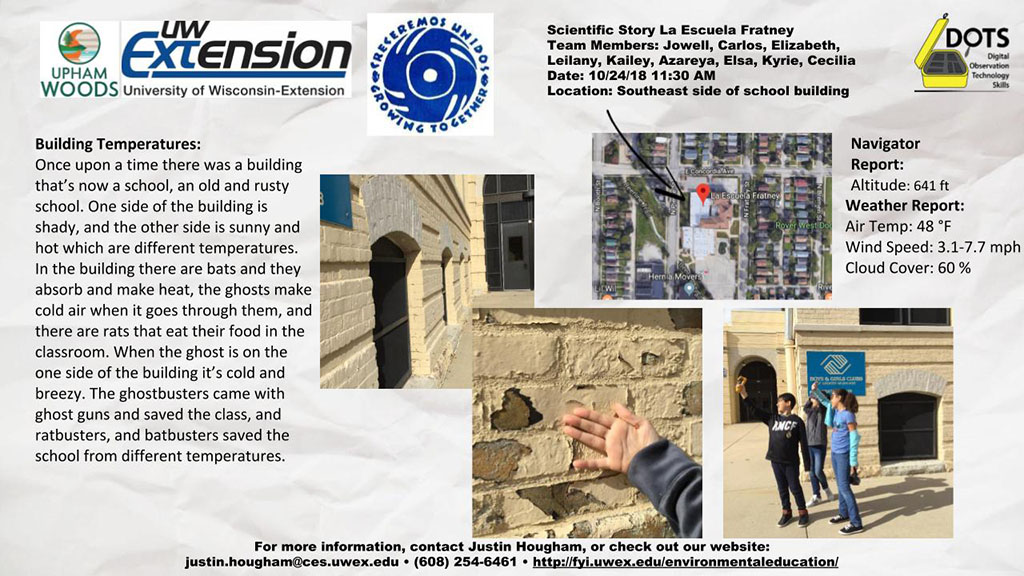
In November, this La Escuela Fratney class then visited the Upham Woods Outdoor Learning Center to collect comparative data for their projects and participate in our outdoor education lessons and programming. All students brought with them the story they had previously created as well as the data they had collected in order to continue investigating their questions. The case study group went on to collect data on the buildings at Upham Woods to make comparisons. Figure 5 shows the students adapting their procedure to a new context while building upon previously developed strategies for data collection and recording. Having prior familiarity with the Scientific Storytelling process, the students were able to focus their time at Upham on adapting their procedure for the new setting and comparing the data with their previous findings.
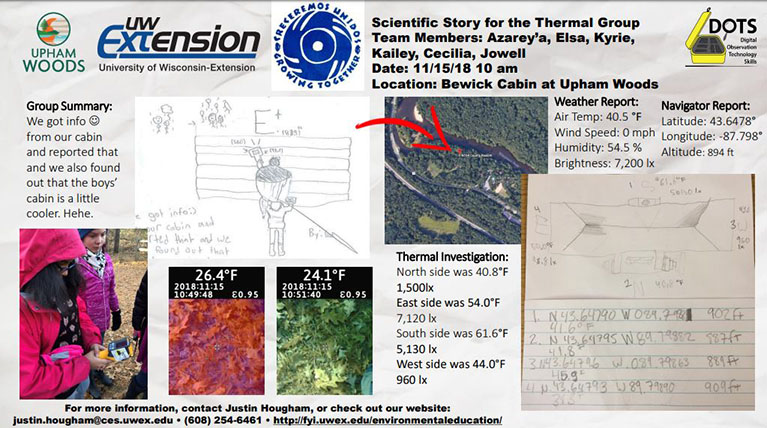
Back in their classrooms in January, the case study group was developing new questions based on its data and had abandoned the ghost storyline for one more scientifically focused (see Figure 6). At this point, the students used Scientific Storytelling to self-report and to track their project’s progression. They could revisit their story each time and write a new one when they were ready. The Scientific Stories that the students created reflect the growth in their science practice skills, developed throughout their projects.
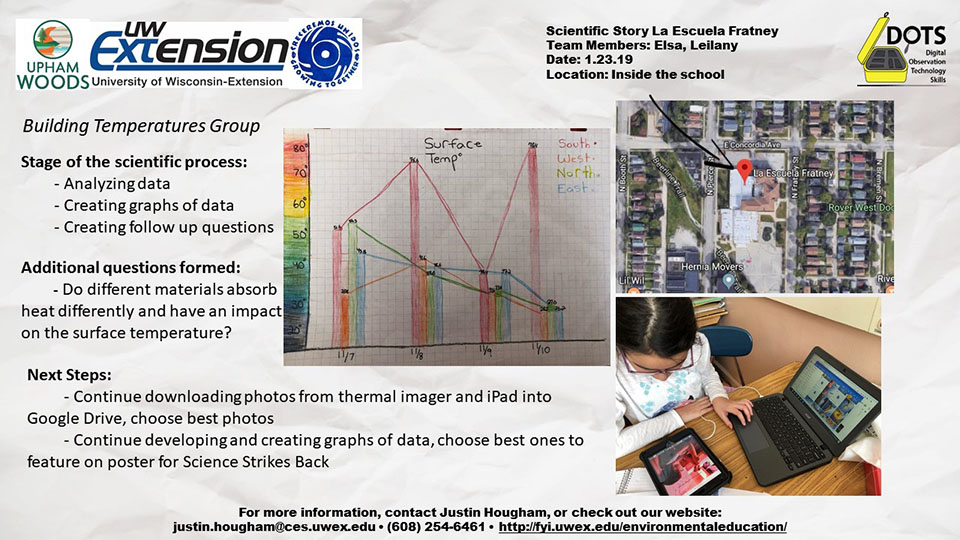
The Scientific Stories shown in Figures 4–6 were all written by the case study group; the unique style and format reflects the stage of scientific exploration the students were in. Scientific Storytelling helped the students creatively engage with their data and continue their research projects over time with direction and purpose. Students in the class also participated in each other’s research process by responding to and providing feedback for their peers’ Scientific Stories. Students asked questions in response to the Scientific Stories; they wondered what they would have noticed or what outstanding questions they had at the end of the story. We found that integrating storytelling into the science lessons grounded the experiences for students, who were challenged by new science content or developing skills in new contexts. Some students who were not as engaged during the data collection were the most excited during the Scientific Storytelling portion, because the process allows students to communicate data on their own terms while developing scientific reasoning and science skills.
Classroom teacher-practitioner perspective
This section was written by the classroom teacher-partner, Sarah Oszuscik, to provide direct insight to her perspective:
“Scientific Stories can be a tool to connect in-school and field trip experiences. By incorporating data into a narrative, students create a place-based experience, real or imagined, that roots the process of scientific observation and data collection. The Scientific Story more broadly engages both learners and those who read the stories to extend beyond those who are drawn to tables and graphs alone. Creating Scientific Stories in the classroom and on school grounds enables students to develop research plans, diving into data that sparked their curiosity and extending it to locations beyond the schoolyard during field trips in order to make comparisons and draw conclusions. The process of telling a compelling, digestible, and memorable Scientific Story is of paramount importance as it connects scientists and their research with the public. Setting students up with a format and process for Scientific Storytelling is invaluable preparation for a scientifically literate public.”
Discussion: Scientific Storytelling for 21st-century science education
Science communication and acquisition of scientific language skills
Scientific Storytelling as a teaching approach allows teachers to focus on both science learning and literacy objectives by providing students opportunities for language use through authentic communication. In an education context, when students are engaged in storytelling, they are developing literacy skills including vocabulary acquisition, logic, and critical thinking (Miller and Pennycuff 2008). The diverse formats of a Scientific Story give ELLs, among others, the opportunity to contextualize their science experience in culturally and developmentally appropriate ways through poems, drawings, pictures, and other media.
Supporting creativity in science
Imagination supports learners in making sense of the world and contributes to their creative and intellectual development (Vygotsky 1991). Creativity is the combination of imagination, elements of prior experience, and new information. Vygotsky (1991) considers the development of imagination as important and necessary for the scientific creativity of children as it is for arts. Scientific Storytelling is an entry point to scientific inquiry, allowing students the opportunity to connect observations and data in new and creative ways.
Data literacy skills and scientific reasoning
Vahey et al. (2006) argue that to experience true data literacy, students must be deeply anchored in context. Scientific Storytelling allows students to situate data within a particular context and attach meaning to data that could otherwise be disembodied or abstract. In particular, Scientific Storytelling grounds inquiry in phenomena of interest to the student, allowing them to draw upon their prior ideas and revise them as they develop explanations (National Academies of Science, Engineering, and Medicine 2018). When students evaluate evidence based on their data in their stories, they are engaging in scientific reasoning, interpretation, argumentation, and communication. Scientific Storytelling can, therefore, support teachers and students in framing authentic questions and developing pathways to evaluate information and reach explanations (Dahlstrom and Scheufele 2018; Furtak and Penuel 2019).
Equitable and relevant STEM education
A Framework for K–12 Science Education (NRC, 2012) calls explicitly for science and engineering education that emphasizes and addresses students’ personal and community concerns. The Scientific Storytelling approach is grounded in concepts of culturally responsive pedagogy, including the belief that students should have learning opportunities that allow them to draw upon their own “funds of knowledge” as a valuable resource that can be acknowledged and aligned with instruction (González 2005). Students need opportunities to situate their learning within the context of their lives and as a social process (González 2005), and scientific stories allow diverse learners to draw upon prior experiences and understandings to construct explanations through the creation of narratives. Inviting personal experience into a scientific discussion emphasizes relationships between the experience, narrator, and scientific data. By expanding the learner experience beyond content and especially toward relationship-building, educators disrupt paradigms in science around the position of the scientist as objective observer and the discourse around who creates science. This disruption of power engages a broader and more diverse group of learners, addressing issues around education equity (Zocher and Hougham, 2020).
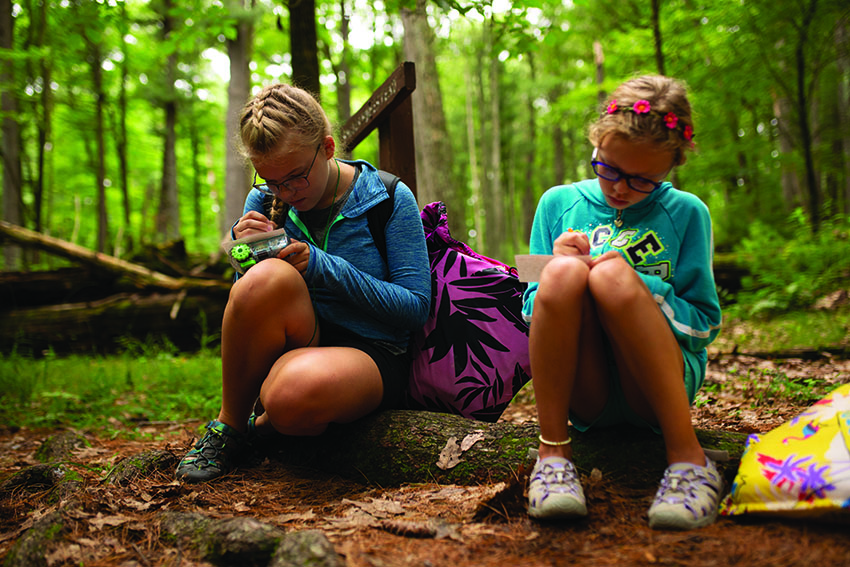
Motivation for learning
Positive personal experiences with science can encourage students to continue studying science. Emotional involvement through storytelling allows for personalization and internalization of scientific understanding, supporting a “sense of wonderment, enthusiasm and interest in science” and encouraging students’ motivation to learn (Rowcliffe 2004, p. 121). Because their story inherently belongs to them, students have a sense of ownership over their narratives and therefore their learning. This emotional engagement leads to deeper reflection and connection to their scientific experience.
Conclusion
Upham Woods has continued to expand storytelling in classrooms through the Milwaukee Environmental-STEM (E-STEM) Project. The Milwaukee E-STEM Project is an Upham Woods–led collaboration between formal and informal educators united in providing experiential field experiences for urban youth through inquiry-based instruction. The fall 2019 semester produced 38 Scientific Stories as result of Upham-led in-classroom facilitations and science practice experiences facilitated by Upham Woods educators. Additionally, every school group that participates in other educational programming at Upham Woods writes a Scientific Story that is then shared with them digitally via e-mail. Such visiting groups have used their stories to demonstrate to parents and school administrators the importance of field experiences and outdoor science education for youth. Scientific Storytelling at Upham Woods is thus used in multiple ways to bridge experiences students have back to their classroom environments.
Scientific Storytelling at Upham Woods is an important approach for broadening access to science for students who may otherwise face barriers to science learning and engagement. Storytelling provides a social context for learning, allowing students to reflect on what they have learned, communicate meaningfully, and personalize their learning by incorporating aspects of their communities and lived experiences. The approach also builds bridges between classrooms and audiences such as parents, as well as unanticipated audiences who are new to conversations around STEM and STEM education. We believe that Scientific Storytelling can help share science education in ways relevant to communities in the 21st century, especially given the demonstrated increased need for educational online engagement and connections with the COVID-19 pandemic.
R. Justin Hougham (justin.hougham@ces.uwex.edu) is associate professor of environmental education and the director of the Upham Woods Outdoor Learning Center at the University of Wisconsin–Madison Division of Extension in Wisconsin Dells, Wisconsin. Isabelle Herde (isabelle.herde@wisc.edu) is the program director of Upham Woods Outdoor Learning Center at the University of Wisconsin–Madison Division of Extension in Wisconsin Dells, Wisconsin. Jennifer Loveland (jennifer.loveland@wisc.edu) is the office operations associate of Upham Woods Outdoor Learning Center at the University of Wisconsin–Madison Division of Extension in Wisconsin Dells, Wisconsin. Sarah Olsen (sarah.olsen@wisc.edu) was the curriculum and evaluation specialist of Upham Woods Outdoor Learning Center at the University of Wisconsin–Madison Division of Extension in Wisconsin Dells, Wisconsin. Tempestt Morgan (tempestt.morgan@wisc.edu) was the expanding access program coordinator at the University of Wisconsin–Madison Division of Extension in Wisconsin Dells, Wisconsin. Maggie Steinhauer (maggie.steinhauer@wisc.edu) was a research naturalist at the University of Wisconsin–Madison Division of Extension in Wisconsin Dells, Wisconsin. Zoë Goodrow (zoe.goodrow@wisc.edu) is the research program specialist of Upham Woods Outdoor Learning Center at the University of Wisconsin–Madison Division of Extension in Wisconsin Dells, Wisconsin. Max Myers (max@tripleccamp.com) is the assistant director at Triple C Camp in Charlottesville, Virginia. Sarah Oszuscik (sarahbgo@gmail.com) is an adolescent teacher at Maryland Avenue Montessori School in Milwaukee, Wisconsin.
Inquiry Teaching Strategies Informal Education


